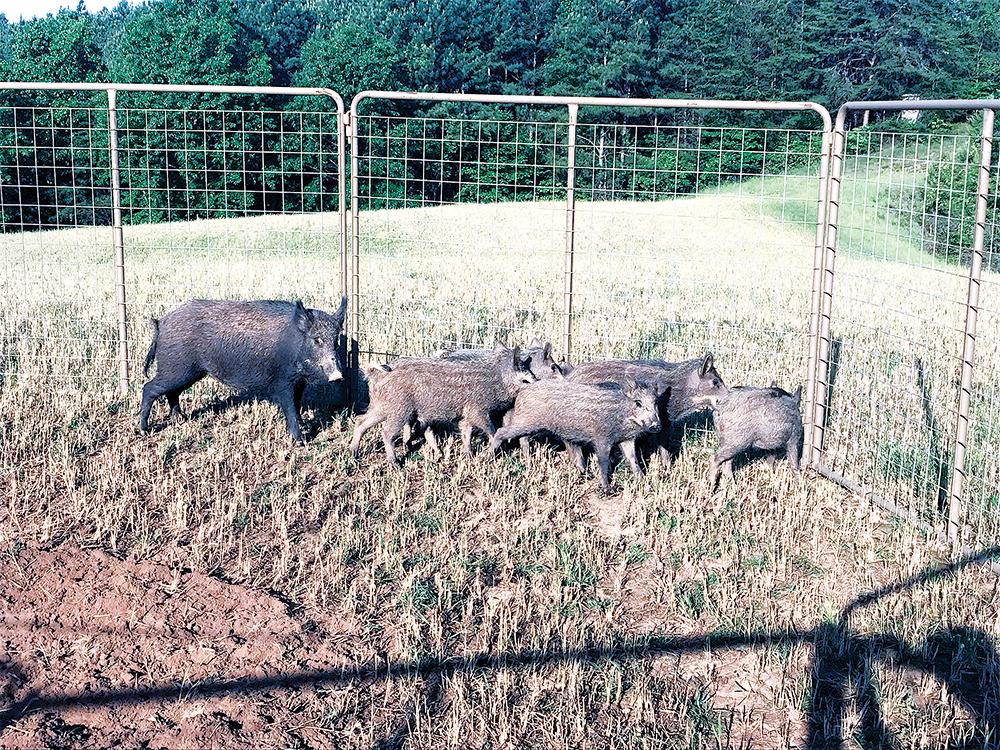By John N. Felsher

When Spanish explorer and conquistador Hernando de Soto landed in North America in 1539, he brought domestic pigs with him to feed his troops. During his wanderings across what would become the southeastern United States, including Alabama, many swine escaped and turned wild. Now, their descendants number in the millions.
“Pigs are extremely prolific,” says Matt Brock, the top wild hog biologist for the Alabama Wildlife and Freshwater Fisheries Division. “Sows can reach sexual maturity as early as six months and reproduce up to twice a year. Generally, they have four to 10 piglets per litter, but average about six to eight.”
Until about three decades ago, wild pig populations in Alabama remained concentrated primarily along the lower Tombigbee and Alabama river drainages. Some people trapped feral swine to release on hunting properties throughout the state. Now, wild hogs populate every county in Alabama.
“Wild hogs don’t naturally expand outward very quickly,” Brock says. “Highly territorial, pigs gather in social groups called sounders that typically occupy about 300 to 900 acres for their home range, depending upon the habitat type. For 450 years, pigs were confined to a few counties in south Alabama, but now they’re everywhere. I don’t know if they have quite reached the same numbers as deer, at least not yet, but in certain parts of the state, they probably have.”
Pigs can cause severe problems for other animals by displacing native wildlife like white-tailed deer and competing with them for food. Pigs eat almost anything. Wild swine can also carry diseases, such as anthrax and brucellosis that could spread to humans, wildlife and domestic livestock.
v“As a state wildlife agency, we want to improve native wildlife populations,” Brock says. “Hogs probably affect deer and deer habitat most, but they can affect small ground-dwelling reptiles, mammals and birds as well. They eat anything that nests on the ground, so hogs are potential threats to those species. They’ll eat quail and quail eggs, but there’s also evidence that they have consumed turkey poults and eggs as well. Anyone who captures a wild hog in Alabama must kill it on site. It’s illegal to transport live wild hogs in the state.”
Effects on the environment
Hogs can also cause significant environmental damage. When searching for food, pigs root around with their noses. After hogs go through an area, it looks like someone rototilled it by plowing up the dirt and uprooting plants that other animals need for food or cover. Feral hogs also consume large quantities of agricultural crops like corn, soybeans and peanuts.
Many people hunt pigs. Landowners can also apply for free permits from any district wildlife office to remove nuisance hogs. With a permit, people can shoot hogs on private property at night during certain months. However, hunters can only do so much to trim burgeoning hog populations.
“To control wild hog populations, people need to kill 70 percent of the pigs in an area annually just to maintain the status quo,” Brock says. “I don’t see recreational hunters killing 70 percent of the hogs across the board, but it might happen on certain properties.”
Some landowners hire hog control experts like Barry and Bart Estes with Alabama Hog Control in Prattville. The Estes brothers use rifles equipped with thermal sights to shoot pigs at night.
“When people are having hog problems, they call us and we do our best to decrease that number dramatically,” Barry says. “In 2018, I killed 1,310 feral hogs. I killed more than a thousand with thermal optics and trapped more than 250.”
To trap pigs, Estes uses a Jager Pro M.I.N.E. Trapping System. M.I.N.E. stands for Manually Initiated Nuisance Elimination. With this system, Estes places bait in a large corral-like trap. Motion sensors send texts to his smart phone when pigs arrive. Estes can remotely watch the trap with video cameras. When the entire sounder enters the corral, he can transmit an electronic code to close the gate.
“We want to catch the whole sounder in a single drop,” Barry says. “If we don’t, the rest get wise. My personal record for a single drop is 51 pigs. I give a lot of pigs away to people who need the meat. I’ve also given away hundreds of pigs to reptile farms and zoos to feed the animals and I’ve donated pigs to wild game cookoffs.”
Landowners can ask state biologists for technical assistance on how to reduce hog populations on their properties. Periodically, officials hold public seminars to teach landowners how to control pigs. For more information, call Brock at 334-549-3032.
Controlling feral hog populations takes time, money and effort. Despite these efforts, feral hog populations will continue to grow in Alabama and elsewhere as de Soto’s gift from centuries ago keeps giving year after year.




